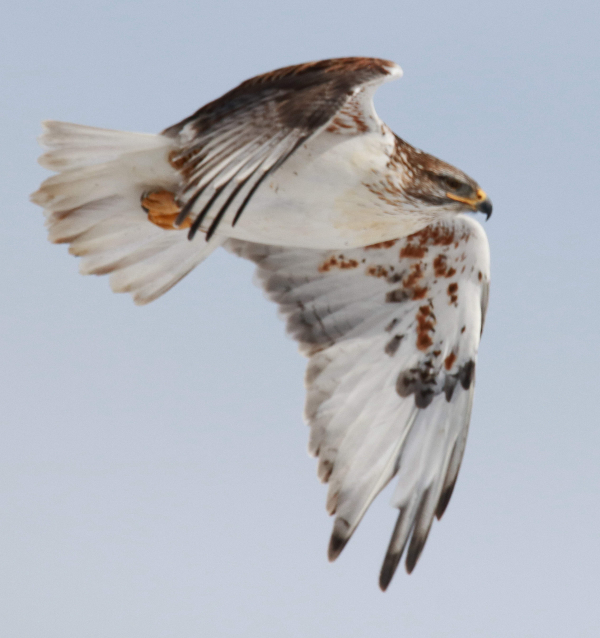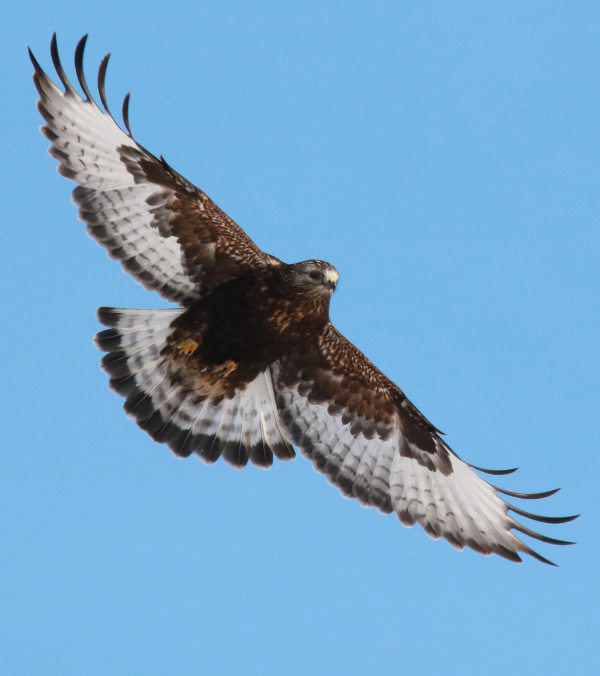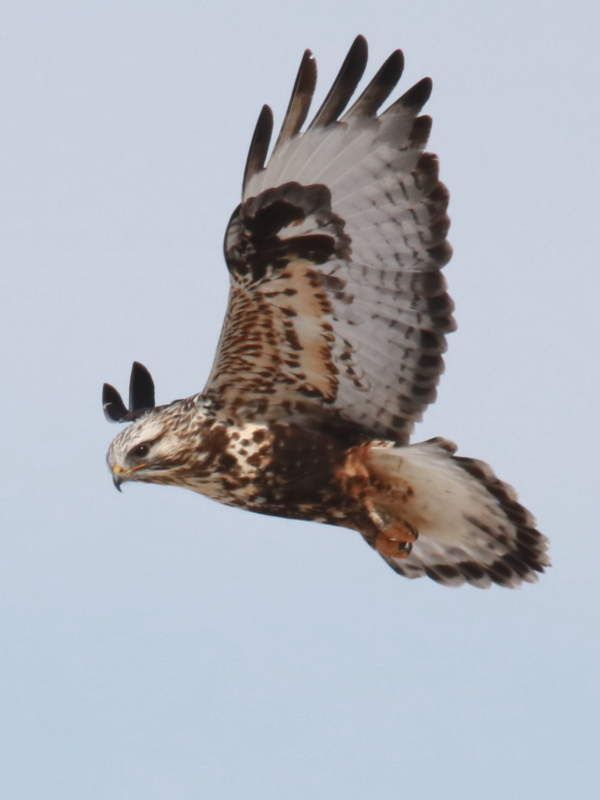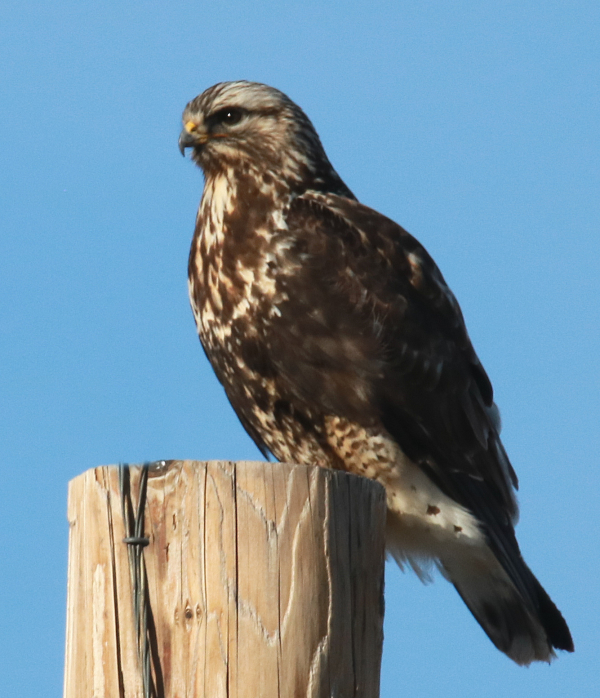
During a Sunday SoDak trip, a variety of birds of prey provided exciting observations and a few exciting photos of a Ferruginous Hawk (above), and in order below, a dark morph Rough-legged Hawk, a hovering light morph Rough-leg, and an interesting intermediate Rough-legged Hawk perched.



|
What a turnaround, and what a thrilling day as I made my way south to Pierre. Turnaround because there were more birds of prey north of Pierre in a greater variety than I’ve seen all winter. It seemed to me that raptors were beginning to make their way north – maybe a pre-migration push by some – after all, March first was only 36 hours away. That thought really hit me when I saw a beautiful silver male Northern Harrier hunting in low flight along the roadside, but that was after already seeing 3 Bald Eagles, 4 Rough-legged Hawks, and a Red-tailed Hawk.
Within a short distance of the harrier I was excited to find a Ferruginous Hawk, a Prairie Falcon, another Rough-leg, and a Golden Eagle! More Rough-legs followed, and within 3 miles of Pierre I observed 2 black morph Harlan’s Red-tailed Hawks separated only by about a mile, plus another Rough-legged Hawk and a regular ole Red-tail. With such great luck north of the capitol city, I was really excited to see the birds to the south of Pierre, where wintering raptors have always been much more abundant, especially this year. But that’s when fate raised its hand to halt my southbound progress.
A sudden incessant dinging alarm alerted be to my dash, only to see my vehicle was overheating – yikes! Luckily I was only 2 miles from the edge of the capitol city, so I stopped the vehicle, let it cool down, then drove cautiously as far as I could get. As the dinging resumed its hot radiator alarm, I pulled into the first business on the north side of Pierre, a new restaurant by chance, and checked under the hood. There was some steam pressure hissing from the radiator, so I checked for a leak and found nothing obvious. Hmm, I already realized this could mean an overnight stay if a radiator hose, water pump, or the radiator itself was the problem.
Leaving the vehicle to cool, I ordered a quick afternoon lunch, then filled the radiator with water with the hope the van would magically be good to go. I bought a couple more gallons of water just in case, and figured I’d try driving back north and see how far I could get. Expecting the worst, which is unlike me, and hoping for the best, it seemed like a foregone conclusion that I’d be back in Pierre before long.
But low and behold, luck and a few other blessings were on my side, and I never looked back. I made it home without incident, even stopping to photograph a Golden Eagle, a Merlin, and a couple more Rough-legged Hawks on my way back. How lucky was I? Likewise, I was also very lucky that after almost a week of horrible below zero temperatures with intense wind, the weather had warmed to a balmy 46 degrees Sunday in Pierre. But there was also still the question of why the radiator was so low on water. With all the emergency equipment I carry with me on the road, it’s almost impossible to take care of problems of the engine, transmission, starter, suspension, and similar vehicle concerns.
Back to the Birds
My total raptor count north of Pierre was 30, which is at least 3 times as many as I’ve seen during any other trips south. And as I said, south of Pierre I tend to find 2 or 3 or 4 times as many raptors as I find north of the capitol city. It was tough to turn back, but I’m glad I made it home just after dark! Sunday’s total of 9 species included 2 species of eagles, 4 of hawks, and 3 of falcons. That included 2 Golden Eagles, 4 Bald Eagles, 14 Rough-legged Hawks (including 4 dark morphs), 5 Red-tailed Hawks (including 2 dark-morph Harlan’s Red-tails), a male Ferruginous Hawk, a male Northern Harrier, a male Prairie Falcon, an immature or female Merlin, and the first American Kestrel of spring – a female hunting on the hover near Pierre.
Notable was the high percentage of dark morph hawks: 4 of 14 Rough-legs and 2 of 5 Red-tails. The Merlin was of the pale Prairie race, and it’s interesting to note that I found the tan-colored Merlin on the same perch as I observed the Prairie Falcon earlier in the day. In fact, at first I thought it was the Prairie Falcon, until I first realized it had very faint malar markings (moustache lines), then noticed the size differential, but I’ve noted before that the Prairie Merlins resemble miniature Prairie Falcons, so this example certainly lends credence to that impression. The only non-adult Bald Eagle was a 4 year old that showed white tail feathers with a dark brown terminal band and a whitish head with a dark mask that ran from its bill to its eyes to its nape – quite an interesting individual that I wish I had been able to get better photos of as it circled just a little too far away.
Throughout much of the day there was exceptionally beautiful sunlight, and several of the above raptors provided nice photo opportunities. Some provided documentary photos that I wish had turned out better, and some birds just didn’t give me any kind of a chance for photos. But one dark morph Roughleg, a light morph Roughleg, and the Ferruginous Hawk provided the best images of the day – hooray! The stars of my documentary photos included a couple Bald Eagles, a Golden Eagle, both the dark morph Harlan’s Red-tails, and a couple other Rough-legs (but no falcon fotos for me).
One more raptor report: Although several of the birds of prey were obviously hunting, including the hovering American Kestrel and a couple hovering Rough-legged Hawks, I was able to see 4 raptors make strikes at potential prey. It was exciting to see the Prairie Falcon dive after 2 Horned Larks in flight; the Ferruginous Hawk made a strike into short grass, undoubtedly at a small rodent; a black morph Rough-legged Hawk made a strike into short grass at the top of a prairie hill, and another Rough-leg made a strike to the ground in a harvested ag field – all unsuccessful.
Night Owls
After arriving home Sunday evening, with an overhead setting of a clear sky and bright stars, a Great Horned Owl broke the deep silence, calling from about a quarter mile to the east. During a subsequent return to my vehicle the owl appeared to have moved to a location about the same distance to the west. That’s when it began interacting vocally with a distant Great Horned Owl that answered its calls from about a mile to the west. The back and forth hooting calls continued for the 10 minutes I stayed outdoors to listen, and while I meant to check back again later, I became consumed in reviewing the raptor photos I took earlier in that day.
The nighttime owl activities reminded me that Great Horned Owls will begin nesting in a couple weeks in this high latitude area of the Great Plains. In retrospect, they could be nesting south of Pierre any day, if the first females haven’t already laid eggs. After almost a week of severe winter cold and wind, warmer daytime temperatures above 35 suddenly bring thoughts of spring and the nesting season for Great Horned Owls to mind.
River Run
During a Thursday afternoon trip to the other Dakota capitol, Bismarck, I observed a Northern Shrike in flight above Beaver Creek, a few miles east of the Missouri River. A bit farther west an immature Bald Eagle was coursing the creek’s floodplain on the hunt. After turning north and skirting the east side of the big river, it was a bit of a revelation to see a perched Rough-legged Hawk. I appreciated a close view of a pair of male Ring-necked Pheasants fly before me, with a memorable view as one banked with its back toward showing the usually less than obvious green dorsal feathers and long trailing tailfeathers widely spread.
With many errands to run in town, the afternoon sunshine beckoned me to continue north of the city another 10 miles. About 7 miles along that route hundreds of Canada Geese and Mallards were congregating flock after flock to feed on the edge of a corn stubble field. As I focused on the waterfowl in flight, I was surprised to see that as the geese and ducks fed, most laid down in the light snow cover to glean kernels of corn. I’ve rarely witnessed this means of feeding before and wondered why they would lay on the cold snowy ground.
About that time, a Rough-legged Hawk flew in to a nearby perch, perhaps hoping a rodent would be displaced by the feasting waterfowl. I didn’t get a good look at the hawk until it took flight, revealing it was an impressive black Rough-leg, a dark morph – the last and most interesting bird of the day flying through the sunset light.
Seed Eaters
It’s exciting to report that the tiny Red-breasted Nuthatch has become a daily drop-by at my feeding station, now stopping momentarily at one seed feeder or another for a grab and go moment. Less regular, but still occasional visitors, are the Dark-eyed Junco and the female House Finch – and I’m on the lookout for the next new birds to add to the mix of Common Redpolls, White-breasted Nuthatches, Hairy Woodpeckers, and Downys.
Then Tuesday as I was putting the finishing touches on this issue of The Birding Wire, a beautiful female Ring-necked Pheasant spent most of the afternoon within sight of my bay windows as she foraged and rested, foraged and rested some more. She didn’t come to my feeding station, but she was only 50 feet away – gracias mi amiga.
What early signs of spring are you seeing as March begins? Birds fill our lives with excitement, and it’s well worth taking a hike or a drive beyond our regular birding realm to increase the excitement potential. I always like to get a feel for changes in the bigger picture by getting a broader overview of what’s happening, and I was lucky enough to do that twice last week – west to the Missouri River Valley and the north capitol, and later to the south capitol of Dakota – and I was especially excited to find the first suggestions of a spring change in the Northern Plains. Without question, there are months of spring excitement ahead.
Article and photos by Paul Konrad
Share your bird sightings and photographs at editorstbw2@gmail.com